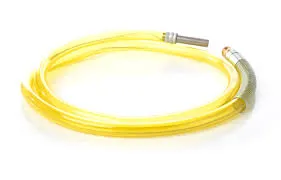335345435
Nov . 11, 2024 12:17 Back to list
hose fittings types pdf
Understanding Hose Fitting Types A Comprehensive Overview
Hose fittings are crucial components in various industrial applications, serving as connectors between hoses and other equipment. Understanding the different types of hose fittings is essential for ensuring the efficiency, safety, and reliability of fluid transfer systems. This article explores the various types of hose fittings, their characteristics, and their applications.
Types of Hose Fittings
1. Barbed Fittings Barbed fittings are among the simplest and most commonly used hose fittings. They feature ridges or 'barbs' that grip the inside of the hose, creating a secure connection. Ideal for low-pressure applications, they are often used in garden hoses and aquarium systems. The ease of installation makes them a popular choice, but they are not recommended for high-pressure systems due to the risk of hose blow-off.
2. NPT Fittings (National Pipe Thread) NPT fittings are threaded connectors that use a tapered thread design to create a seal when tightened. These fittings are widely used in various applications, including plumbing, fuel systems, and high-pressure environments. They provide a strong, leak-proof connection and can be found in both male and female configurations. The versatility of NPT fittings makes them suitable for hydraulic systems, air lines, and more.
3. Quick Connect/Disconnect Fittings Designed for convenience and speed, quick connect/disconnect fittings allow for rapid attachment and detachment of hoses. They are particularly beneficial in environments where frequent disconnecting is necessary, such as in industrial cleaning systems or fluid transfer processes. These fittings come in various styles, including push-to-connect and snap-on designs, providing flexibility based on specific needs.
4. Camlock Fittings Camlock fittings utilize a mechanism with a cam lever to secure the connection between the hose and fitting. They are commonly used in the agricultural, chemical, and food industries due to their ease of use and ability to handle larger volumes of liquid. The quick-release feature enables fast disconnections without the need for special tools.
hose fittings types pdf

5. Flanged Fittings Flanged fittings consist of a flat surface with holes for bolts, allowing for a secure connection between pipes and hoses. This type of fitting is typically used in high-pressure applications, such as in the oil and gas industry, where robust connections are essential. They provide excellent strength and are suitable for both liquid and gas applications.
6. Swivel Fittings Swivel fittings are designed to allow rotation, which can be particularly advantageous in applications where hoses need to maneuver or change orientation frequently. These fittings reduce strain on the hose and can prevent kinks, making them ideal for hydraulic systems and mobile equipment.
Material Considerations
Hose fittings can be made from various materials, including brass, stainless steel, plastic, and aluminum. The choice of material often depends on factors such as the type of fluid being transferred, pressure ratings, and environmental conditions. For instance, stainless steel is preferred for corrosive fluids, while plastic may be sufficient for low-pressure situations.
Conclusion
In summary, understanding the various types of hose fittings and their applications is fundamental for anyone involved in fluid transfer systems. Selecting the right fitting can greatly enhance system efficiency and safety. Whether you opt for barbed fittings, quick disconnects, or flanged options, each type serves a unique purpose tailored to specific operational needs. As industries continue to evolve, so too will the technology and design of hose fittings, ensuring safer and more efficient fluid transfer solutions.
-
SAE 100 R17 Black Smooth Cover Hydraulic Hose
NewsMar.07,2025
-
SAE 100 R17 Black Smooth Cover Hydraulic Hose
NewsMar.07,2025
-
SAE 100 R17 Black Smooth Cover Hydraulic Hose
NewsMar.07,2025
-
SAE 100 R17 Black Smooth Cover Hydraulic Hose
NewsMar.07,2025
-
SAE 100 R17 Black Smooth Cover Hydraulic Hose
NewsMar.07,2025
-
steel wire braided hydraulic hose
NewsMar.07,2025



